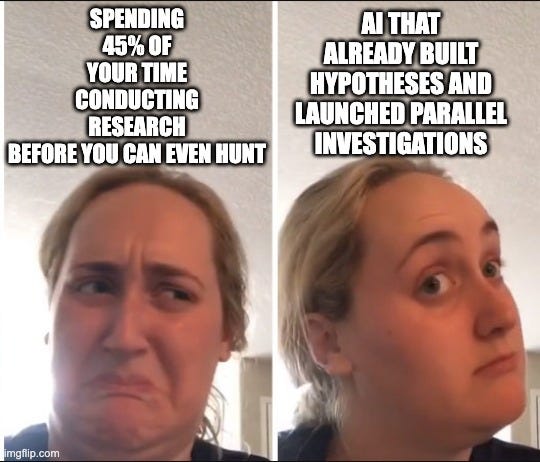The Agentic Threat Hunter
We’re done playing whack-a-mole.
Threat hunting is broken. Not in theory, in execution. We’re still using human brains to chase anomalies across petabytes of data while adversaries automate everything. It’s time to flip the script.
Enter the agentic threat hunter. A new breed of AI system that doesn’t just assist analysts, it thinks with them. It hypothesizes. Investigates. Correlates. Triages. Evolves. And most importantly: it scales.
Inspired by this sharp piece from Anvilogic on automating the scientific method for detection engineering, and this talk about using agentic workflows for threat detection by the security team at Anthropic.
The Bitter Lesson, Now in Cyber
AI researchers have a saying: The Bitter Lesson. It’s the harsh but proven truth that general methods leveraging computation always win out over handcrafted, human-tuned approaches. In cybersecurity, we’ve ignored this for years, trying to scale threat hunting with more analysts, more training, more frameworks.
Meanwhile, attackers have embraced automation, leaving us in the dust.
We don’t need another playbook. We need to evolve the player.
Threat Hunting Was Always Scientific
Hunting has always followed the scientific method: observe, hypothesize, test, iterate. It’s what separates real hunting from reactive alert triage.
But this method breaks down under today’s pressure. Data volumes have exploded. Security stacks are fragmented. Skilled analysts are burned out. And the median time from breach to data theft? Just two days.
The methodology still works. Humans just can’t keep up.
Agentic AI Is the Upgrade
Agentic systems aren’t just fancy automation. They’re autonomous collaborators that can:
Generate hypotheses on their own, using threat intel and behavioral patterns
Collect and correlate data across tools and time windows
Run parallel investigations, not one query at a time
Learn continuously and evolve with each hunt
Respond and adapt in real time, with human-in-the-loop feedback
It’s not just about scale—it’s a new form of cognition. One that never gets tired, distracted, or stuck in a console timeout.
From Data Analyst to AI Supervisor
Agentic hunting doesn’t replace the human. It amplifies us.
Hunters move from query monkeys to strategy leads. Junior analysts get mentorship baked into the system. Senior analysts spend less time hunting for logs and more time hunting for truths.
This isn’t theoretical. Companies using agentic platforms are already seeing results:
Insider threats discovered in hours instead of weeks
Sophisticated attacks caught by patterns no human would correlate
Analyst burnout plummeting while productivity surges
How to Start Building Toward Agentic Threat Hunting
You don’t need to wait for a million-dollar platform or magic vendor AI to start moving toward agentic hunting. You can begin now, with the tools you already have.
Here’s where to start:
1. Treat Hypotheses Like Code
Start writing down your hunt hypotheses in structured form. Track them. Version them. Iterate. Use a doc, a repo, a Notion board—whatever. The point is: make your thinking explicit so it can be scaled and handed off to an agent later.
2. Start Pairing with AI
Use LLMs to accelerate the boring stuff. Have them:
Draft hunt ideas from threat intel reports
Suggest Splunk queries based on behaviors
Summarize investigation findings
You’re not just saving time, you’re training the AI how you think.
3. Fix Your Data Access
Agentic systems are only as good as the data they can reach. If your telemetry lives in 9 different tools with no correlation layer, you’ve already lost. Start building a unified view now. Via a SIEM, data lake, or even APIs.
4. Automate the Repetitive, Keep the Creative
Look at where your team spends time on rinse-and-repeat investigations. Those are prime candidates for autonomy. Use automation for triage and enrichment so your humans can focus on strategy and weirdness.
5. Set Guardrails Before You Scale
Don’t wait until something breaks. Define what your agents can do without approval. Set escalation paths. Build trust by reviewing decisions together. Autonomy works best when the humans stay in the loop. On purpose.
You don’t need a PhD. You need a willingness to evolve. And a bias for building.
The Autonomous SOC Isn’t Sci-Fi
The future is already taking shape: SOCs where agents hypothesize, investigate, and respond with minimal human direction. Where AI systems don’t just react to threats, they anticipate them. And where lessons from one org improve defenses for everyone.
This is the arms race now: not just attacker vs. defender, but AI vs. AI. And the edge goes to those who can combine machine speed with human strategy.
Final Thought
We’re at the inflection point. The threat hunters of tomorrow won’t be the ones who wrote the best queries. They’ll be the ones who taught the best agents. Who paired creativity with computation.
Agentic threat hunting isn’t the future. It’s the now. And it’s the only way forward.
You in?





Interesting take on the topic. I chatted with several SOC analysts and managers and this is their view:
https://cybersecandbiz.substack.com/p/ai-in-threat-hunting-in-the-soc